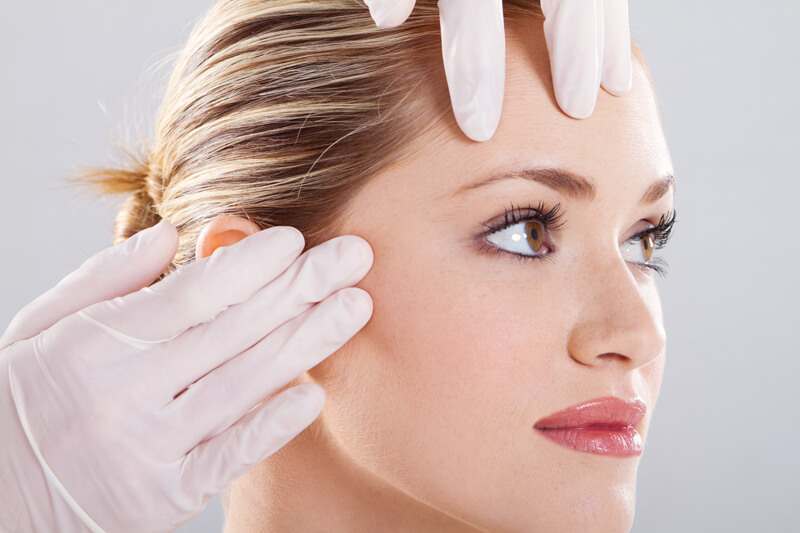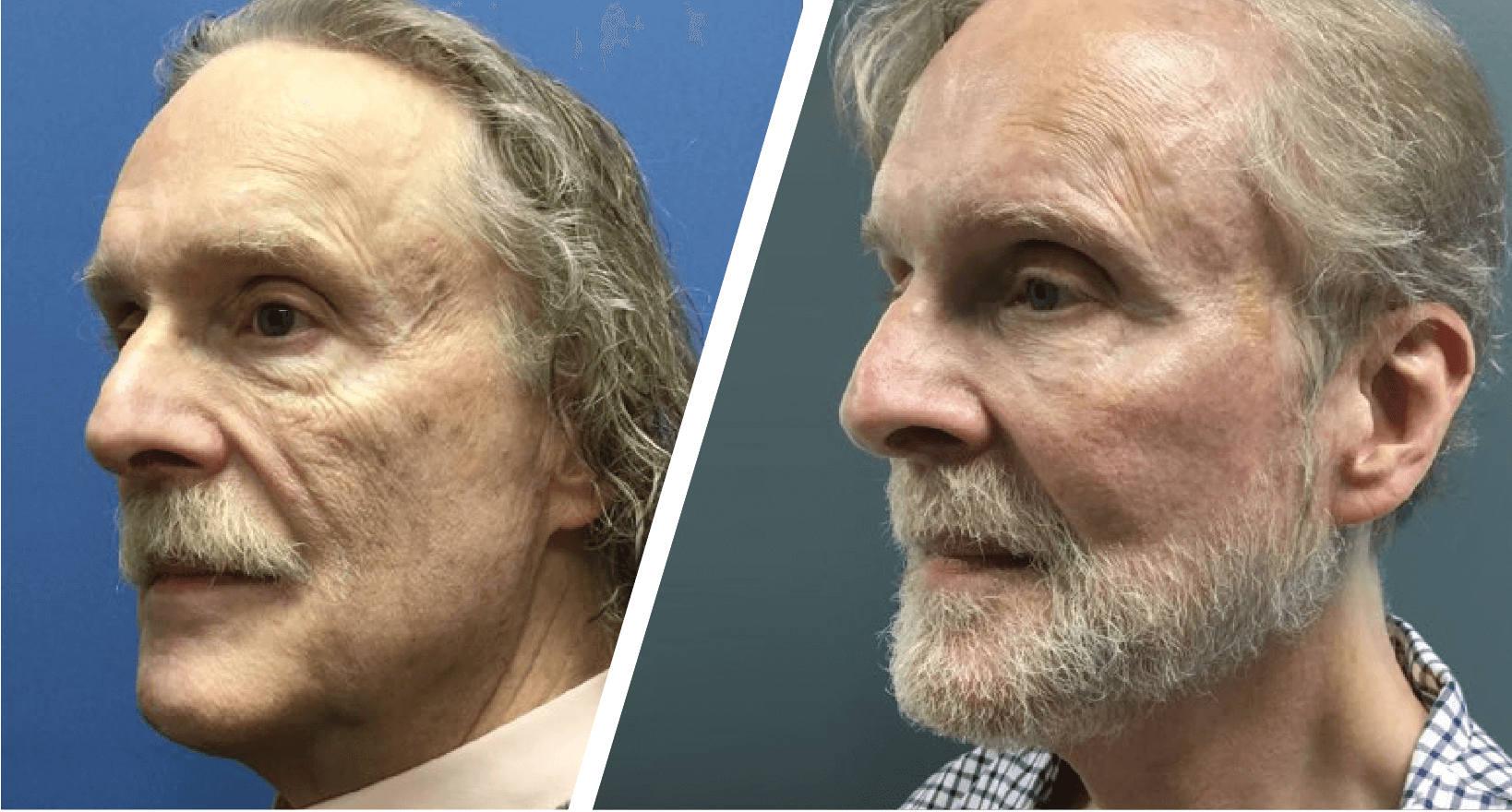 A face lift, also known as rhytidectomy, can make the face look more attractive by creating a better-balanced and more youthful triangular shape. Classic images of beauty include timeless artistic impressions of Nefertiti. In these depictions, she is always portrayed very angular in shape with a very “triangulated” face.
A face lift, also known as rhytidectomy, can make the face look more attractive by creating a better-balanced and more youthful triangular shape. Classic images of beauty include timeless artistic impressions of Nefertiti. In these depictions, she is always portrayed very angular in shape with a very “triangulated” face.
During the aging process, whether caused from chronological years, environmental changes, stress, weight loss, or a combination of these, the face appears to deflate. These deflated features lead to an imbalance of structural support under the skin of our face due to a mismatch between the bone and fat to the facial skin. This leads to sagging. Face lifts of all types serve to restore this balance by removing skin and, in most instances, adding some lost volume. There are many different types of face lifts, including SMAS, Deep Plane, Skin Only, Mid face, Mini, MACS, and Short Scar.
During your consultation with Dr. Bortnick, he will discuss different types of surgical options. Face lift surgery can be combined with other cosmetic procedures such as brow lift or eyelid surgery.
Am I a good candidate for face lift surgery?
During your consultation, Dr. Bortnick will help you determine if a face lift is right for you. Remember that the goal of face lift surgery is not agelessness. Rather, its goal is the restoration of the attractiveness of youth. This primarily involves the rematching of the volume of the face structure to youthful, strong, and angular proportions and re-draping the skin to match the restored shape.
Face lift surgery is not designed to make you look different. Patients often ask what they might look like after surgery. Although no one can show for certain, one of the best simulations is to observe yourself in a hand mirror while lying flat on your back or while pulling the tissues of your face upwards from a point on the outermost portion of your cheek bone.
For all elective surgeries, we recommend:
- Patients must be aware of the known negative effects of any surgery, including pain, cost, recovery time, scarring, and the known risks.
- Patients should lead a healthy lifestyle and be healthy both medically and emotionally. Any surgery is a trauma to the body, so it is important to be in good health before the procedure.
- Patients should be at a point in their lives where inconveniences to job responsibilities and family obligations are minimized.
- It is imperative that cosmetic surgery patients be non-smokers, as nicotine delays the healing process.
Assuming that you have a healthy, non smoking lifestyle and are medically and emotionally prepared for surgery, you may be an excellent candidate for a face lift. Most patients are in their forties to sixties, but age is not a limiting factor.
What should I expect during the consultation?
 During the consultation, you should expect to meet with Dr. Bortnick for 30 – 45 minutes. Be prepared to review all of your prior medical history, including past surgeries, current medications, drug allergies, social history, and tobacco use. In preparation for the consultation, spend some time looking at yourself in a mirror, both upright and lying down. Bring with you a list of three facial features that you like and three that you dislike the most. If possible, bring photographs of yourself from 10 – 15 years ago. These will help Dr. Bortnick in determining which type of face lift would be best for you. You will also be given the costs of the surgery, which will include costs for your hospital stay, anesthesia, and any ancillary procedures. Although informed consents for the planned procedures will be given to you during your visit, they are also available here. You may wish to download the forms prior to consultation so that you can ask Dr. Bortnick any specific questions regarding risks.
During the consultation, you should expect to meet with Dr. Bortnick for 30 – 45 minutes. Be prepared to review all of your prior medical history, including past surgeries, current medications, drug allergies, social history, and tobacco use. In preparation for the consultation, spend some time looking at yourself in a mirror, both upright and lying down. Bring with you a list of three facial features that you like and three that you dislike the most. If possible, bring photographs of yourself from 10 – 15 years ago. These will help Dr. Bortnick in determining which type of face lift would be best for you. You will also be given the costs of the surgery, which will include costs for your hospital stay, anesthesia, and any ancillary procedures. Although informed consents for the planned procedures will be given to you during your visit, they are also available here. You may wish to download the forms prior to consultation so that you can ask Dr. Bortnick any specific questions regarding risks.
How is the surgery performed?
Face lift surgery is always performed in an accredited surgery facility with anesthesia administered under the supervision of a board certified anesthesiologist. Control of blood pressure during the entire duration of the surgery reduces the risks of bleeding after the surgery and ensures optimum recovery. You will go all the way to sleep during the surgery.
Before surgery starts, marks for planned incisions will be placed on your face by Dr. Bortnick and your photographs will be reviewed. Medications to help reduce swelling and reduce anxiety will be administered prior to the start of surgery. Incisions are most often made immediately in front of the ear or within the ear canal and extend behind the ear to the back of the hairline. A small incision is made under the chin to allow access to the loose muscles of the neck and jaw line.
The surgery most often starts with the neck and progresses upward, pushing the tissue higher in a sweeping motion to recreate the appearance of lying on your back. Redundant tissue is removed, and a small drain is placed behind the ear to drain any fluid that accumulates over night. Other procedures, such as eyelid surgeries, chemical peels, or fat grafting, are done after the face lift is complete. Loose dressing are put in place and a light compressive bandage is applied. Surgery usually takes between 3 and 4 1/2 hours depending on the type of procedure being performed.
Plan on spending an hour in the recovery room before being discharged to home. You will be seen back in the office the next morning. More information of pre- and post-operative care can be found here.

